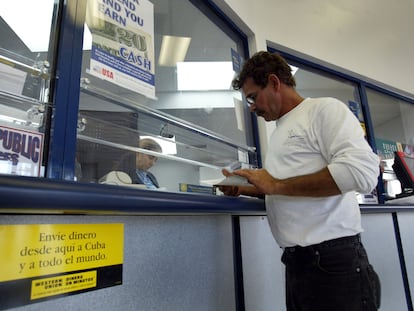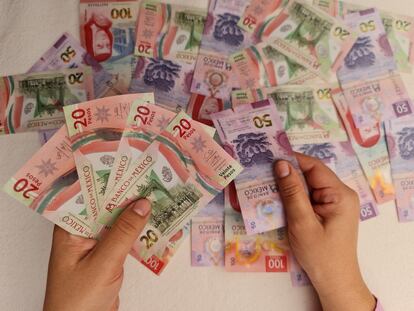Credit card frenzy in Mexico: Government assistance boosts credit and consumption
Anticipating an increase in the amount of federal government social benefits, Mexicans are taking on debt to purchase more. Spending during the country’s Independence Day celebrations reached its highest level in five years

Last weekend’s national holiday in Mexico had the greatest economic impact that such celebrations have had since Andrés Manuel López Obrador became president in December 2018. In part, that’s because the financial aid that the Mexican government gives some sectors of the population is boosting consumption. And with it, the use of credit cards.
According to the Confederation of National Chambers of Commerce, Services and Tourism (Concanaco Servytur), the country’s Independence Day celebrations, which were held on Friday night, September 15 (and, in many cases, lasted until Sunday), generated economic activity in the amount of 23 billion pesos ($1.3 billion), the most spending that has occurred on this holiday during the López Obrador administration thus far. Mexico City alone received 105,408 visitors, both domestic and foreign, who poured 7.797 billion pesos ($456 million) into the local economy in one weekend.
This year, there has also been more spending during the country’s most important celebrations, such as Mother’s Day in May, an increase in consumption driven by the government’s social programs, explains Gabriela Siller, an economist and the director of analysis at Banco Base.
“Consumption in Mexico has benefited from a decrease in the unemployment rate [and] an increase in salaries, which together have led to a higher real wage bill, as well as from increased government aid,” explains Siller, who is also a professor at Monterrey Tech. Remittances sent by Mexican nationals in the United States to their relatives in Mexico are one of the country’s most important sources of foreign currency. However, remittances have lost purchasing power, since they are sent in dollars, and the exchange rate with the Mexican peso has appreciated by 10% so far this year.
“What is offsetting the decline in remittances’ purchasing power? The expectation that deposits [of aid] are going to increase next year, which has led to an increase in the amount of credit granted,” Siller points out. Mexico’s president said so himself. On August 22, he announced in a press conference that pensions for senior citizens will increase by 25% next year. There are also direct aid programs for young people, parents and farmers that are meant to increase.
Banco de México figures confirm the trend of Mexicans spending more on credit cards. In July, credit card payments amounted to 702.4 million pesos ($41 million), the highest level so far this year. That happened despite the fact that interest rates are at historic highs since the financial system uses the central bank rate as a reference and it is currently at 11.25%. The country’s next big consumption peak is expected to occur between November 17 and 20, when the nationwide weekend of sales (called “Buen Fin [Good Weekend]”) takes place.
Mexicans do not tend to react to interest rate hikes, Siller explains. “There is not much of a financial culture, and they do not notice the high interest rates that they’re paying,” she says. In addition, Siller says, “if deposits are going to increase 25%, an interest rate of 11% per annum, the 25% increase in pensions is enough to cover future spending.” The Ministry of Finance has submitted its 2024 budget proposal, which includes spending on social aid deposits that amounts to nearly 13% of the Gross Domestic Product, a level that the Ministry itself referred to as “unprecedented.” To achieve this, the debt will be raised to 48.8% of GDP.
In an April lecture at the Autonomous University of Mexico (UNAM), the Secretary of Finance said that private consumption is contributing 70% to the country’s post-pandemic economic recovery, so the economy is growing more than anticipated. Both the agency and the average of analysts’ forecasts point to GDP growth above 3% this year.
“Consumption is an internal motor of growth,” says Siller. “However, it is only short-term growth. Growth should be the consequence of productive investment, that is, a greater amount of gross fixed investment. Increasing consumption through money transfers is like a car that runs but [only] because you’re pushing it. You can’t push it forever.”
Siller and other analysts have warned of the risk of unsustainability for López Obrador’s social aid deposits and the possibility that the next administration will be forced to pass a tax reform raising revenue to pay for pensions. “In the following year, we could have growth between 2% and 2.5%,” Siller opines, “but if a super deficit occurs, it is highly likely that rating agencies will lower [the country’s] rating or downgrade the outlook from stable to negative in 2025, and that might put more pressure on the Mexican government to enact fiscal reform, which would lead to economic growth of less than 1% in 2025.″
Sign up for our weekly newsletter to get more English-language news coverage from EL PAÍS USA Edition
Tu suscripción se está usando en otro dispositivo
¿Quieres añadir otro usuario a tu suscripción?
Si continúas leyendo en este dispositivo, no se podrá leer en el otro.
FlechaTu suscripción se está usando en otro dispositivo y solo puedes acceder a EL PAÍS desde un dispositivo a la vez.
Si quieres compartir tu cuenta, cambia tu suscripción a la modalidad Premium, así podrás añadir otro usuario. Cada uno accederá con su propia cuenta de email, lo que os permitirá personalizar vuestra experiencia en EL PAÍS.
¿Tienes una suscripción de empresa? Accede aquí para contratar más cuentas.
En el caso de no saber quién está usando tu cuenta, te recomendamos cambiar tu contraseña aquí.
Si decides continuar compartiendo tu cuenta, este mensaje se mostrará en tu dispositivo y en el de la otra persona que está usando tu cuenta de forma indefinida, afectando a tu experiencia de lectura. Puedes consultar aquí los términos y condiciones de la suscripción digital.
More information
Archived In
Últimas noticias
Most viewed
- Sinaloa Cartel war is taking its toll on Los Chapitos
- Oona Chaplin: ‘I told James Cameron that I was living in a treehouse and starting a permaculture project with a friend’
- Reinhard Genzel, Nobel laureate in physics: ‘One-minute videos will never give you the truth’
- Why the price of coffee has skyrocketed: from Brazilian plantations to specialty coffee houses
- Silver prices are going crazy: This is what’s fueling the rally











































